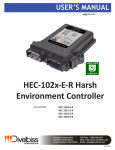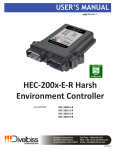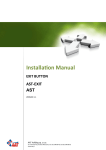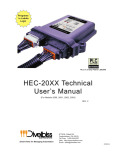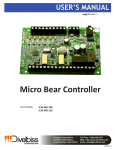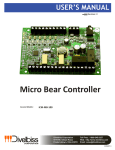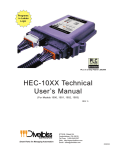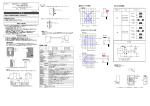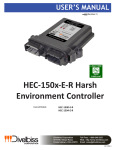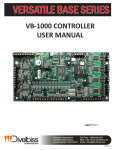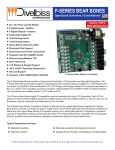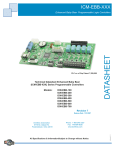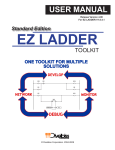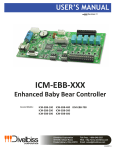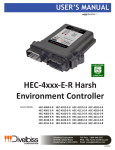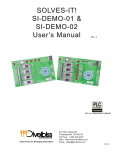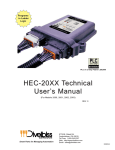Download HEC-102x Harsh Environment Controller
Transcript
USER’S MANUAL Revision: 0 HEC-102x Harsh Environment Controller Covered Models: HEC-1020 HEC-1021 HEC-1022 HEC-1023 Divelbiss Corporation 9778 Mt. Gilead Road, Fredericktown, Ohio 43019 Toll Free: 1-800-245-2327 Web: http://www.divelbiss.com Email: [email protected] 2009004.0 Table of Contents Manual Contents Getting Started How to Use this Manual........................................................................ 3 Configuring the HEC-102x Target in EZ LADDER Toolkit......................... 4 Getting to Know the HEC-102x.............................................................. 4 HEC-102x Features Programming Port................................................................................. 8 Watchdog LED....................................................................................... 9 Input Power........................................................................................... 9 Mounting............................................................................................. 10 Digital Inputs....................................................................................... 11 Counter Inputs..................................................................................... 12 Digital Outputs..................................................................................... 13 Pulse Width Modulation Outputs........................................................ 14 Thermistor Inputs................................................................................ 16 Real Time Clock................................................................................... 18 General Purpose Serial Ports............................................................... 18 CAN Networking Ports......................................................................... 19 Specifications....................................................................................... 20 WARNING!! The HEC-102x, as with other programmable controllers must not be used alone in applications which could be hazardous to personnel in the event of failure of this device. Precautions must be taken by the user to provide mechanical and/or electrical safeguards external to this device. This device is NOT APPROVED for domestic or human medical use. HEC-102X User’s Manual Document #: 2009004.0.pdf Divelbiss Corporation • 9778 Mt. Gilead Road • Fredericktown, Ohio 43019 • 1-800-245-2327 • www.divelbiss.com PAGE 1 of 20 Getting Started This section explains how to read this manual and understand the symbols and information that it contains. To begin using your HEC Controller, you will need to follow these steps: • Install EZ LADDER Toolkit if not already installed (not included). • Configure the HEC Controller in the EZ LADDER Toolkit Project Settings. • Using purchased or self-made cables, connect the Input Power and Programming Port. • Write a ladder diagram program. • Download and run the program on the HEC Controller. Refer to the appropriate sections of this manual for details on the above items. Getting Started How to Use this Manual In this manual, the following conventions are used to distinguish elements of text: BOLD italic SMALL CAPS Denotes labeling, commands, and literal portions of syntax that must appear exactly as shown. Used for variables and placeholders that represent the type of text to be entered by the user. Used to show key sequences or actual buttons, such as OK, where the user clicks the OK button. In addition, the following symbols appear periodically in the left margin to call the readers attention to specific details in the text: Warns the reader of a potential danger or hazard associated with certain actions. Appears when the text contains a tip that is especially useful. Indicates the text contains information to which the reader should pay particularly close attention. All Specifications and Information Subject to Change without Notice HEC-102X User’s Manual Document #: 2009004.0.pdf Divelbiss Corporation • 9778 Mt. Gilead Road • Fredericktown, Ohio 43019 • 1-800-245-2327 • www.divelbiss.com PAGE 3 of 20 Getting Started Configuring the HEC-102x Target in EZ LADDER Toolkit Before you can program and use the HEC Controller, it must be configured as a target within the EZ LADDER Toolkit. For help with installing or using EZ LADDER, please refer to the EZ LADDER User’s Manual. 1. In EZ LADDER, from the File Menu at the top, click PROJECT then SETTINGS. This will open the Project Settings Window. Select HEC-1000 as the target from the choices. Refer to Figure 1.1. Figure 1.1 - Project Settings Window 2. Click OK. This will close the Project Settings Window, saving the HEC-1000 as the target for this ladder diagram project. Getting to Know the HEC-102x The HEC-102x Controller is designed to provide powerful programmable features in a tough, harsh environment resistant package. The main features of the HEC-102x are accessed via sealed Deutsch connectors that will be referred to as the ‘A’ connector which is grey and the ‘B’ connector which is black. Refer to Figure 1.2, it it illustrates the HEC-102x. HEC-102X User’s Manual Document #: 2009004.0.pdf Divelbiss Corporation • 9778 Mt. Gilead Road • Fredericktown, Ohio 43019 • 1-800-245-2327 • www.divelbiss.com PAGE 4 of 20 Getting Started Figure 1.2 - HEC-102x Product Drawing Each HEC connector is a Deutsch sealed connector with 12 connections each. The mating connectors for the HEC’s connectors is sold separately. Connectors may be purchased as kits or cable assemblies may be purchases with the mating connectors pre-wired with flying leads on one end. In addition to connectors and kits for standard wiring, several programming break-out cable assemblies may be purchased. Refer to Figure 1.3 for the HEC-102x A and B connector front view Pin Assignments. A B Figure 1.3 - HEC-102x A / B Connector Front View HEC-102X User’s Manual Document #: 2009004.0.pdf Divelbiss Corporation • 9778 Mt. Gilead Road • Fredericktown, Ohio 43019 • 1-800-245-2327 • www.divelbiss.com PAGE 5 of 20 Getting Started A and B Connector Pin Functions CONNECTOR ‘A’ (GRAY) CONNECTOR ‘B’ (BLACK) CAN 0 Hi CAN 0 Low CAN 4 Hi CAN 4 Low Programming Port TX Programming Port RX +VDC Input Power +VDC Input Power +VDC Input Power -DC / Input Power Common Thermistor - Analog Input 0 Thermistor - Analog Input 1 Output 0 / PWM 0 (GPO0/PWM0) Output 1 / PWM 1 (GPO1/PWM1) Output 2 / PWM 2 (GPO2/PWM2) Output 3 / PWM 3 (GPO3/PWM3) Output 4 / PWM 4 (GPO4/PWM4) Output 5 / PWM 5 (GPO5/PWM5) Input 0 / CNTR 1 (GPI0/CNTR1) Input 1 / CNTR 2 (GPI1/CNTR2) Input 2 (GPI2) Input 3 (GPI3) Input 4 (GPI4) Input 5 (GPI5) Pin 1 Pin 2 Pin 3 Pin 4 Pin 5 Pin 6 Pin 7 Pin 8 Pin 9 Pin 10 Pin 11 Pin 12 HEC-102X User’s Manual Pin 1 Pin 2 Pin 3 Pin 4 Pin 5 Pin 6 Pin 7 Pin 8 Pin 9 Pin 10 Pin 11 Pin 12 Document #: 2009004.0.pdf Divelbiss Corporation • 9778 Mt. Gilead Road • Fredericktown, Ohio 43019 • 1-800-245-2327 • www.divelbiss.com PAGE 6 of 20 HEC-102x Features This section explains the Harsh Environment Controller (HEC-102x) hardware features, options and information regarding EZ LADDER Toolkit for basic operation. HEC-102x Features Programming Port The HEC-102x is programmed using its Programming Port (COM 0). This RS232 serial port is only to be used for programming using Divelbiss EZ LADDER Toolkit software. This is not a general purpose port and may not be used in any other capacity than programming the controller itself. The Programming Port defaults to: Baud: Parity: Data Bits: Stop Bits : 57600 None 8 1 The HEC-102x Programming Port is wired through the A Connector just as other features. The Programming Port requires a NULL MODEM cable or connection to the computer to establish communications between EZ LADDER Toolkit and the HEC Controller. This connection may be made by manufacturing your own programming cable. The mating connector for the HEC-102x Programming Port may be purchased as a kits (HEC-10, Requires special Crimp Tool) or a complete pre-wired assembly for the A Connector (HEC-100). Ideally, the best option is to purchase the HEC-910 Breakout Cable Assembly. This cable assembly connects in-line with all connected devices and provides an RS232 9-pin D Male connector as the interface. This also requires a null modem cable (ICMCA-34) that connects from the HEC-910 to the computer serial port. While this is the most commonly used programming cable set, other programming cable set options are available. Refer to Figure 2.1 for Direct Connections and Figure 2.2 for the HEC-900 Break-out method. Figure 2.1 - Programming Port Direct Connection HEC-102X User’s Manual Document #: 2009004.0.pdf Divelbiss Corporation • 9778 Mt. Gilead Road • Fredericktown, Ohio 43019 • 1-800-245-2327 • www.divelbiss.com PAGE 8 of 20 HEC-102x Features Figure 2.2 - Programming Port Break-out Connections Watchdog LED The operating status of the HEC-102x can be determined the by Watchdog LED. When the Watchdog LED is flashing at a slow rate, approximately once per second, then there is no ladder program executing. When the Watchdog LED is flashing at a fast rate, approximately 10 times per second, a program has been loaded and it is executing. Should the Watchdog LED not flash at all, first check the input power. If the input power is correct and there is still no Watchdog LED, contact Divelbiss Technical Services. Input Power The HEC-102x may be powered using 12-26.4VDC. The input power must be of sufficient supply to drive the HEC controller and all the digital outputs (based on the load currents for each). Due to wire size limitations of the HEC-102x connectors, multiple input power pins are provided to allow for parallel input power lines to increase the amount of current (for heavier output loads). For an input power wiring diagram, refer to Figure 2.3. HEC-102X User’s Manual Document #: 2009004.0.pdf Divelbiss Corporation • 9778 Mt. Gilead Road • Fredericktown, Ohio 43019 • 1-800-245-2327 • www.divelbiss.com PAGE 9 of 20 HEC-102x Features Figure 2.3 - Input Power Connections Mounting The HEC-102x mounts simply using two mounting screws. The HEC can easily accept mounting screws up to 1/4” in diameter. Figure 2.4 - HEC-102x Mounting HEC-102X User’s Manual Document #: 2009004.0.pdf Divelbiss Corporation • 9778 Mt. Gilead Road • Fredericktown, Ohio 43019 • 1-800-245-2327 • www.divelbiss.com PAGE 10 of 20 HEC-102x Features Digital Inputs The HEC-102x includes 6 on-board digital inputs. They are identified in EZ LADDER Toolkit and this manual as GPI0 through GPI5. Each digital input can accept an input voltage of 12-26.4 VDC. The presence of this voltage on an input will result in the input being read as TRUE in the ladder diagram. GPI0 and GPI1 may be used as general purpose digital inputs or high speed counters; while GPI2 - GPI5 can only be used as general purpose digital inputs. For information on using GPI0 or GPI1 as high speed counter inputs, refer the COUNTER INPUTS Section of this User’s Manual. To read a digital input status in a ladder diagram, place and connect the appropriate contact for your needs. The DIRECT CONTACT and INVERTED CONTACT functions are used to read digital inputs in the ladder diagram. When placing the contact, verify you select the correct input address (GPI0 - GPI5) from the provided drop-down menu. It is important that the input device source be the same as the HEC-102x input power source as shown. Separate power sources could result in a damage to the controller if input power is lost, but the inputs are still powered. Refer to Figure 2.5. Figure 2.5 - Typical Digital Input Connections HEC-102X User’s Manual Document #: 2009004.0.pdf Divelbiss Corporation • 9778 Mt. Gilead Road • Fredericktown, Ohio 43019 • 1-800-245-2327 • www.divelbiss.com PAGE 11 of 20 HEC-102x Features Counter Inputs As was noted in the Digital Inputs Section, two of the digital inputs (GPI0, GPI1) may be utilized as high speed counters (up counting only). These inputs will accept a maximum frequency of 40KHz and are optically isolated to promote noise immunity. These inputs are ideal to anywhere that high speed counting is required; such as calculating RPM, batch counting and more. To use GPI0 or GPI1 in a ladder diagram as a high speed counter, you must use the CNTRMR function block. This block, when placed in the ladder diagram, will provide a drop-down menu to select which counter to use. Refer to the EZ LADDER Toolkit User’s Manual for details on the CNTRTMR and other function blocks. GPI0 is Counter Channel 1 while GPI1 is Counter Channel 2 in the CNTRTMR function block. Please note: Individually, the GPI0 and GPI1 inputs are designed to be used as a digital input only or high speed counter input only. EZ LADDER will allow the placement of contacts and /or CNTRTMR function in any program. Therefore, you can place and use the contacts and the CNTRTMR function block in the same program with the same digital input selected. This can be useful in some programs based on the application, but it is important to know that input contacts will only operate at a fraction of the frequency that the CNTRTMR function block can accurately read. Typical High Speed Counter connections are shown in Figure 2.6. Figure 2.6 - Typical Counter Input Connections HEC-102X User’s Manual Document #: 2009004.0.pdf Divelbiss Corporation • 9778 Mt. Gilead Road • Fredericktown, Ohio 43019 • 1-800-245-2327 • www.divelbiss.com PAGE 12 of 20 HEC-102x Features Digital Outputs The HEC-102x includes 6 on-board digital outputs. They are identified in the EZ LADDER Toolkit and this manual as GPO0 - GPO5. These outputs are sourcing, therefore an energized output will source an output voltage equal to the controller input voltage. Refer to Figure 2.7 for typical output connections. Each output can drive a load up to maximum current rating listed in the specifications section (resistive) and includes an automatic over-current shutdown safety. In the event an over current condition exists, the output will shut down. This shut down condition is reset when the output is turned off (set to false) in the ladder diagram. Each output requires a minimum load to operate correctly. Depending upon the device connected to an output, a minimum load resistor may be required. If the output is ON or true regardless of the ladder diagram program, connect a 470Ω to 1KΩ load from the output to input power common. Each digital may be configured and used as a digital output or as a Pulse Width Modulation (PWM). Each output may only be used as either digital output or PWM output only. For information on using digital outputs as PWM outputs, refer to the Pulse Width Modulation Outputs Section of this manual. To control a digital output in a ladder diagram, place and connect the appropriate coil for your needs. The DIRECT COIL and INVERTED COIL functions are used to control digital outputs in the ladder diagram. When placing the coil, verify you select the correct output address (GPO0 - GPO5) from the provided drop-down menu. In addition to controlling the outputs, the status of each digital output may be monitored for an OK or Fault status. When the HEC102x target is configured in EZ LADDER, 6 status variables are created automatically, idenfitied (STAT0 - STAT6). These variables indicate the status of the output and may be used in the program as any boolean variable (DIRECT CONTACT or INVERTED CONTACT). A High or True condition indicates that the output is functioning properly while a Low or False condition indicates a fault condition of the output (open load or overload). Figure 2.7 - Typical Digital Output Connections HEC-102X User’s Manual Document #: 2009004.0.pdf Divelbiss Corporation • 9778 Mt. Gilead Road • Fredericktown, Ohio 43019 • 1-800-245-2327 • www.divelbiss.com PAGE 13 of 20 HEC-102x Features Pulse Width Modulation Outputs As previously noted, the HEC-102x includes 6 on-board digital outputs that may be configured individually and exclusively as either digital outputs or pulse width modulation outputs; therefore, each output may only be used as either digital output or PWM output. Before Pulse Width Modulation outputs may be used in the ladder diagram, the Pulse Width Modulation Properties must be configured in EZ LADDER Toolkit. To Configure Pulse Width Modulation (PWM) Outputs in EZ LADDER Toolkit: 1. In EZ LADDER, from the File Menu at the top, click PROJECT then SETTINGS. This will open the Project Settings Window. The HEC-1000 was previously selected. 2. Click the PROPERTIES button. The HEC-1000 Properties Window will open. Refer to Figure 2.8. Figure 2.8 - HEC-1000 Properties Window 3. Click the PWM PROPERTIES button. The PWM Properties Window will open. Refer to Figure 2.9. Figure 2.9 - PWM Properties Window HEC-102X User’s Manual Document #: 2009004.0.pdf Divelbiss Corporation • 9778 Mt. Gilead Road • Fredericktown, Ohio 43019 • 1-800-245-2327 • www.divelbiss.com PAGE 14 of 20 HEC-102x Features 4. Click the ADD button in the PWM Properties window. 5. In the ADD PWM dialog, select the channels to install. To select multiple PWM channels, hold the CTRL key while clicking on the channel. Refer to Figure 2.10. The channels are as follows: Digital Output 0 - PWM 0 Digital Output 3 - PWM 3 Digital Output 1 - PWM 1 Digital Output 4 - PWM 4 Digital Output 2 - PWM 2 Digital Output 5 - PWM 5 Figure 2.10 - ADD PWM Window 6. Click OK to close the ADD PWM dialog. The next step is configuring the frequencies. 7. Enter the desired frequency for Clock A and Clock B (if installed). The HEC has 6 available PWM Channels. These channels are either controlled with Clock A or Clock B. This allows two different PWM frequencies. The Minimum and Maximum frequencies are displayed in the PWM Properties dialog. The frequency for Clock A and Clock B must be in this range. Refer to Figure 2.9. Due to limitations of hardware, the Desired Frequency and Actual Frequency may vary. The Actual Frequency will be the closest attainable frequency to the entered Desired Frequency. 8. Click OK to close the PWM Properties Window. Click OK to close the HEC-1000 Properties Window and click OK to close the Project Settings Window. With the Pulse Width Modulation Outputs configured in EZ LADDER, they can now be used in the ladder diagram project. The PWM channel(s) are controlled in the ladder diagram by the PWM and PWM_FREQ function blocks. For each PWM channel required, a PWM function block is required. Typically, PWM Outputs operate at a set frequency while the Duty Cycle is adjusted to vary the output. The Duty Cycle is a variable input to the PWM function block. In the event the frequency must be changed during operation, the PWM_FREQ function block is used. Refer to the EZ LADDER Toolkit User’s Manual for more detail regarding function blocks and variables. Refer to Figure 2.11 for PWM channel connections. HEC-102X User’s Manual Document #: 2009004.0.pdf Divelbiss Corporation • 9778 Mt. Gilead Road • Fredericktown, Ohio 43019 • 1-800-245-2327 • www.divelbiss.com PAGE 15 of 20 HEC-102x Features Figure 2.11 - Typical PWM Output Connections`` Thermistor Inputs The HEC-102x provides 2 on-board, 10-bit resolution thermistor inputs (analog inputs). Each thermistor input is designed to operate with NAPA part number TS4015 or thermistors with equivalent specifications and characteristics. The temperature range for the specified thermistor is 0-160° F. Figure 2.12A shows the typical connections for using the thermistor inputs. Using any thermistor that is not an equivalent replacement by specifications and characteristics will cause erroneous readings. Consult factory for other thermistor and thermistor temperature ranges. Each thermistor (analog) input is represented in the EZ LADDER Toolkit ladder diagram using variables labeled AN0 and AN1 respectively. Both variable were created automatically when the HEC-1000 target was selected in the Project Settings Window. Each variable (AN0 and AN1) will represent the current reading on the input as an integer number (0-1023). These values are not representative of the temperature. These values must be used to calculate the temperature based on the actual thermistor characteristics. For the HEC-102x to calculate temperature based on the thermistor inputs, two variables :Slope and Intercept are required as well as some ladder diagram programming. These two variables are used in the ladder diagram to calculate the actual temperature reading of the thermistor inputs. For the thermistor specified (TS4015), the Slope = -.18799 and the Intercept = 185.2978. This calculation method provides flexibility towards the use of other thermistors. HEC-102X User’s Manual Document #: 2009004.0.pdf Divelbiss Corporation • 9778 Mt. Gilead Road • Fredericktown, Ohio 43019 • 1-800-245-2327 • www.divelbiss.com PAGE 16 of 20 HEC-102x Features Figure 2.12A - Typical Thermistor Input Connections Using the Slope and Intercept, it is simple to calculate the actual temperature based on the analog input reading, the slope and the intercept. The calculation in the ladder diagram is: Temperature = (Analog Input x Slope) + Intercept Figure 2.12B illustrates this calculation in a ladder diagram format. For this example, the analog input (AN0) is also being averaged using the AVG function block. Please note: All the variables must be in a REAL format for the calculations of the MULT and ADD function blocks. Figure 2.12B - Thermistor Ladder Diagram Calculations HEC-102X User’s Manual Document #: 2009004.0.pdf Divelbiss Corporation • 9778 Mt. Gilead Road • Fredericktown, Ohio 43019 • 1-800-245-2327 • www.divelbiss.com PAGE 17 of 20 HEC-102x Features Real Time Clock The HEC-102x includes a Real Time Clock. The real time clock (after being set) provides the Month, Day, Day of the Week, Year, Hour, Minute and Second. The real time clock maintains time when power is as long as the internal lithium battery is good. The life of the battery for the real time clock generally has years of life before replacement is needed. Should the battery need to be replaced, replace the battery with the same type and size as the original. Contact product support for information about changing the battery. To use the Real Time Clock functionality in a ladder diagram, several function blocks are available. To read current Time or Date, use the GETTIME and GETDATE function blocks. To set the current Time or Date, use the SETTIME and SETDATE function blocks. General Purpose Serial Ports The HEC-102x optionally may be ordered with a second serial port. This serial port is a general purpose serial port that supports serial printing. This port may also be used to communicate to a Modbus Master Device (the HEC is a Modbus Slave). At this time, the general purpose serial port is an output device only as there is no software support to read a serial input. This port may be factory ordered as HEC-1021 (RS232), HEC-1022 (RS422) or HEC-1023 (RS485). The general purpose serial port connection is achieved by a factory installed cable with an industry standard M8 connector. The HEC-1020 does not have a general purpose serial port. Figure 2.13 illustrates the general purpose serial port cabling. For cable pin assignments, refer to Figure 2.14. Figure 2.13- General Purpose Serial Port HEC-102X User’s Manual Document #: 2009004.0.pdf Divelbiss Corporation • 9778 Mt. Gilead Road • Fredericktown, Ohio 43019 • 1-800-245-2327 • www.divelbiss.com PAGE 18 of 20 HEC-102x Features RS232 Serial Port - HEC-1021 Pin 1 2 3 4 RS485 Serial Port - HEC-1023 Pin 1 2 3 4 ID RX TX GND RTS ID TX+ TX- GND -- FRONT VIEW Description Receive Data Transmit Data Ground Request to Send Description Data (+) Data (-) Ground No Connect A connector cover for General Purpose serial port is available. Order using Divelbiss Part # 120-106189 RS422 Serial Port -HEC-1022 Pin 1 2 3 4 ID RX- RX+ TX+ TX- Description Receive Data (-) Receive Data (+) Transmit Data (+) Transmit Data (-) Figure 2.14 - General Purpose Port Pin Assignments CAN Networking Ports The HEC-102x provides two on-board CAN bus interface ports. These CAN ports may be used for additional communications and networking including SAE J1939 and the Divelbiss proprietary OptiCAN Network. The on-board CAN ports are CAN 0 and CAN 4 respectively. To use the HEC’s CAN ports as either SAE J1939 or OptiCAN, it will be necessary to configure certain parameters. These parameters may be configured from the HEC-1000 Properties Window in the Project Settings. As these settings vary greatly and are software based only, please refer to the EZ LADDER Toolkit User’s Manual for details on configuring, using and implementing CAN port networking including all relevant function blocks. The CAN ports should be wired according to established practices for CAN networks. Figure 2.15 illustrates typical CAN Port connections. HEC-102X User’s Manual Document #: 2009004.0.pdf Divelbiss Corporation • 9778 Mt. Gilead Road • Fredericktown, Ohio 43019 • 1-800-245-2327 • www.divelbiss.com PAGE 19 of 20 HEC-102x Features Figure 2.15 - Typical CAN Port Connections Specifications Processor: Memory: Serial Ports: Networking: Digital I/O: Real Time Clock: Counters: Analog Inputs: PWM Outputs: Input Power: Operating Temp: Program Language: Dimensions: Mounting: Type: Storage Temperature: HEC-102X User’s Manual PLC on a ChipTM 256K Flash, 12K RAM 1 Programming Port (Max baud: 57.6K); 1 Multipurpose Port, Factory Configured as RS232, RS422 or RS485 2 CAN Ports for Divelbiss OptiCan and J1939 Communications 6 Inputs & 6 Outputs on-board, Expandable using OptiCAN Network Inputs rated 10-26.4VDC Outputs rated 3A Maximum (resistive), Over-current protected. Output Voltage = Input Power Time of Day, Day, Month, Year & Day of Week 2 Channels, Count Up, 40KHz Max. (using Digital Inputs 0 and 1) 2 Channels, Thermistor Inputs, Napa Part Number TS4015, 0-160°F 6 Channels 1.465 Hz to 48.0KHz (using Digital Outputs 0-5), 3ADC Maximum 12-26.4VDC -40-70º C Ladder Logic using Divelbiss EZ LADDER Toolkit. 4.63” Wide x 5.24” Length x 1.43” Tall. Panel Mount using screws Enclosed, Sealed Plastic Housing -40-85ºC Document #: 2009004.0.pdf Divelbiss Corporation • 9778 Mt. Gilead Road • Fredericktown, Ohio 43019 • 1-800-245-2327 • www.divelbiss.com PAGE 20 of 20





















